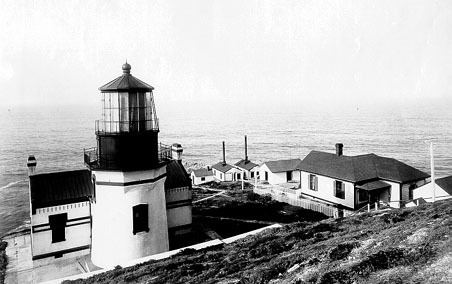Year first constructed 1856 (first) Automated 1973 Address Lompoc, CA 93436, USA Opened 1856 Range 37,040 m Materials Stucco, Wood, Brick | Year first lit 1882 (current) Foundation stone basement Height 16 m Area 12 ha Constructions Stucco, Brick | |
 | ||
Location Point ConceptionCaliforniaUnited States Tower shape cylindrical tower with lantern behind fog signal building Similar Point Arguello Light, Carquinez Strait Light, Farallon Island Light, Table Bluff Light, Santa Barbara Light | ||
Point conception lighthouse usa
Point Conception Light is a lighthouse on Point Conception at the west entrance of the Santa Barbara Channel, California. It is one of the earliest California lighthouses and is listed on the National Register of Historic Places.
Contents
Santa barbara channel
History
Juan Rodríguez Cabrillo sailed along the California coast in search for glory and gold. On October 18, 1542, he encountered heavy winds upon rounding the Point and was forced to turn back to San Miguel Island where he died. Second-in-command Bartolomé Ferrer took charge and again tried to round the Point but he was also unsuccessful.
The Point was named Punta de la Limpia Concepcion by Sebastián Vizcaíno in 1602, who was the next Spanish sailor to venture the Pacific waters along the California coast after Juan Cabrillo. The 1835 experience of the sailing ship Pilgrim, which was damaged and nearly capsized in a sudden change of weather here, is typical of boaters even today.
It was here at Point Conception in 1856, that the lighthouse was built high on the sandstone cliffs, above the location of the present lighthouse. The first order Fresnel lens and steel tower for the lighthouse were made in France at a cost of $65,068 and was transported around Cape Horn. A report indicates that the lighthouse was severely damaged during the Fort Tejon earthquake of January 9, 1857.
The lighthouse was moved in 1881 because the fog would be less likely to obscure the light, and was rebuilt from the top of the bluff to a mesa halfway down, 133 feet (41 m) above the Pacific Ocean. The light station was automated by the United States Coast Guard in 1973.
The lighthouse was used as the location for the film The Monster of Piedras Blancas (1959).
In recent years Vandenberg Air Force Base restricts access from the northwest, and a private ranch restricts access from the adjoining land although a few people have reached the lighthouse by hiking west along the narrow rugged public beach several miles from the nearest road during low tide. Some have also arranged well in advance with the Coast Guard for access.
